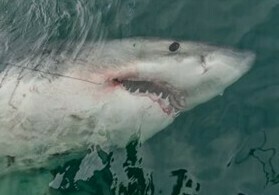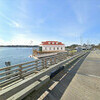Researchers From Canada To Florida Help Boost Great White Shark Research
 LeeBeth, a 14-foot female great white shark, was tagged off South Carolina last summer. ATLANTIC WHITE SHARK CONSERVANCY PHOTO
LeeBeth, a 14-foot female great white shark, was tagged off South Carolina last summer. ATLANTIC WHITE SHARK CONSERVANCY PHOTO
CHATHAM – Cape Cod isn’t the only place that’s seen an increase in the sightings of great white sharks.
Researchers from Canada to Florida have been photographing and tagging the apex predators in recent years, and that’s helped the Chatham-based Atlantic White Shark Conservancy (AWSC) boost its catalog of individual white sharks to more than 700.
Last summer, AWSC researchers, working with Dr. Greg Skomal of the Massachusetts Division of Marine Fisheries, identified 36 new white sharks during 22 research trips. Using video footage provided by Fisheries and Oceans Canada in the Gulf of St. Lawrence and Atlantic Shark Expeditions off the coast of Nova Scotia, another 39 new individual sharks were identified. Eleven more great whites were identified from videos sent to the conservancy by boaters, divers and fishermen, according to an AWSC press release.
The AWSC team also documented 44 previously identified sharks as well as four others already in its database that were recorded by Canadian researchers.
“Individual white sharks travel thousands of miles along the eastern coast of the United States and Canada over the course of the year,” AWSC Senior Scientist Megan Winton said in a statement. “Thanks to the work of our team, our collaborators, and the fishermen, divers, and boaters who provided videos or images of white sharks, we identified 91 new individuals in 2023. We’ve been able to grow the catalog to over 700 individual white sharks documented in the Northwest Atlantic, making it one of the largest photo-ID databases of individual white sharks worldwide.”
Researchers are able to identify individual great white sharks based on their “unique coloration, markings on the gills and fins, and dorsal fin profiles,” according to the conservancy. Underwater footage taken by Skomal on research trips provides close-up views of sharks as they swim in waters off the Cape’s eastern shore. Shark characteristics can be compared to video and photos in the AWSC’s database to determine if the animal has been previously identified. If not, it is entered into the catalog and given a nickname, sometimes inspired by the shark’s individual markings. Recording when individual sharks are seen allows researchers to track the animal’s behavior over time.
Considered the most comprehensive source of photos and information on white sharks that have been identified along the Atlantic coast, the AWSC’s White Shark Catalog includes more than 700 individuals sighted by researchers since 2014. The catalog is available to the public at the conservancy’s website, www.atlanticwhiteshark.org/.
Among the white sharks identified last year was LeeBeth, a 14-foot female tagged off South Carolina in partnership with Chip Michalove of Outcast Sportfishing. LeeBeth went into the record books when she was tracked into the waters off Matamoros, Mexico, which is the farthest west a white shark has been tracked.
“We couldn’t do this work without the support of people on the water serving as our eyes and ears,” said Cynthia Wigren, CEO and co-founder of the Atlantic White Shark Conservancy. “We encourage everyone on the East Coast of the U.S. and Canada who encounters a white shark to send us video footage and photos so we can continue to build and enhance this invaluable catalog.”
Footage of great white sharks captured by members of the public can be sent to the AWSC at info@atlanticwehiteshark.org.
Skomal and the AWSC will be embarking on another research season this summer. This work has thus far has contributed to a number of scientific studies on the Northwest Atlantic white shark population, as well investigations of feeding and other behaviors that help enhance public safety and knowledge about the species.
Please support The Cape Cod Chronicle by subscribing today!
You may also like:




